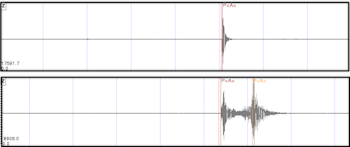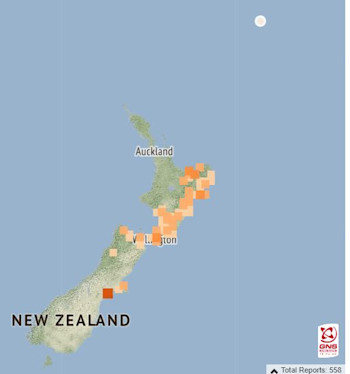
Does GeoNet delete earthquakes?
If you happen to see an earthquake on our app or website that has ‘deleted’ next to it, rest assured it wasn’t an actual earthquake – only the ghost of one! But what does that mean? We look into that below.
Let’s look at an example. Recently a M6.5 earthquake occurred over 900km north-east of New Zealand and was felt by a few people on the east coast of the North Island. Some of those who came to the GeoNet website to report feeling the earthquake noticed a couple of recent earthquakes had been ‘deleted’. So, what are deleted earthquakes?
How our automated system views distant earthquakes
Our earthquake detection system is designed to pick up local earthquakes, so when the seismic waves of a distant event are rolling through our network, our earthquake detection system doesn’t recognise the wave arrivals as coming from one local earthquake and instead makes up many local earthquake detections to explain the unfamiliar seismic waves.
Also, earthquakes are made up of P (primary) waves and S (secondary) waves, among others. P waves travel faster than S waves, so they arrive at a seismic station first. If an earthquake happens a long way from a seismic station, there can be a long delay between the P waves and the S waves arriving – so long that the automatic system thinks that the S waves are the P waves of a separate earthquake.
These false detections from distant earthquakes are what we call “ghost quakes”, and almost as soon as they are created our Geohazard Analysts are working to tidy them up.

The top seismograph shows our system detecting the first P waves arriving from a nearby earthquake. Because the earthquake was nearby the slower S waves arrive very soon afterwards and you cannot distinguish them on the seismograph. The bottom seismograph shows our system detecting the first P waves arriving from a distant earthquake (the red line). Because the earthquake was far away, the slower S waves take a while longer to turn up – so long that our system thinks they are the P waves from a new earthquake (the orange line).

So, you delete earthquakes?
When our Geohazard Analysts review these distant detections, they remove the duplicates created by our system and revise the origin and magnitude of the real earthquake using the data. Almost always this results in the earthquake source moving hundreds of kilometres away into the Kermadec Arc to the north-east of New Zealand, and often with a larger magnitude.
Didn’t you get rid of ‘ghost quakes’?
Back in 2019 following the opening of our National Geohazards Monitoring Centre (NGMC) our Geohazards Analysts were manually reviewing earthquakes. This meant that earthquake information was not displayed on the website or app until it had undergone a preliminary review by a GHAs, so no more ‘ghost quakes’.
Then COVID arrived in Aotearoa New Zealand, and to prepare for possible COVID-related absences in the NGMC, we re-enabled auto publishing of earthquake information. We have decided to keep the auto publishing on indefinitely to enable our vital information to go out to the public no matter what happens in the future (pandemic, geohazard, etc.). It is an important form of resilience in our system that enables earthquake information to be shared with you, even if our people can’t refine the information beforehand.
If we change our automatic system to be picky on the quakes it reports, we might not get information about real earthquakes out rapidly. However, if we let the automatic system report on whatever information it picks up, we sometimes get ghost quakes.
So, while ghost quakes will remain an unfortunate side effect of getting information out to you as quickly as possible, most earthquakes that trigger ghost quakes are too small and too far away to be felt here. Rest assured though that even in a sea of ghost quakes, we will find the real event, clean up its shadows, and keep you well-informed.
Ghost Quakes are a great reminder that we live on a very active tectonic plate boundary here in New Zealand.
For more information on how to get you and your whānau prepared, visit the National Emergency Management Agency’s website getready.govt.nz.
For information on how to prepare your house for earthquakes, check out Toka Tū Ake EQC’s advice for homeowners and renters.
Media enquiries: media@gns.cri.nz or 021 574 541

